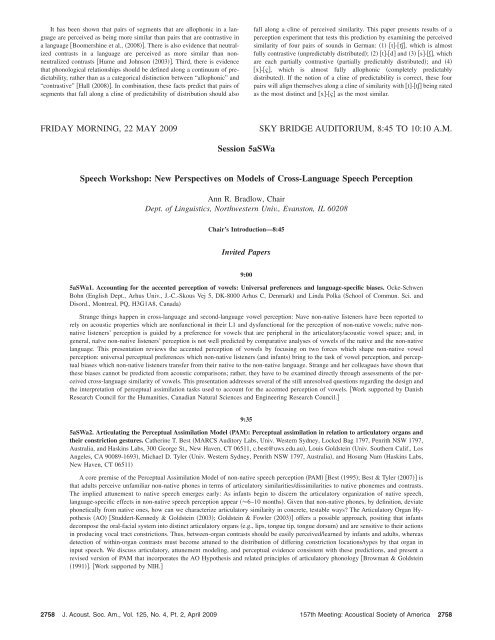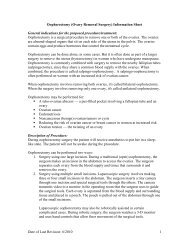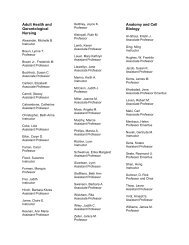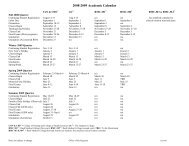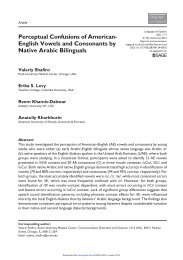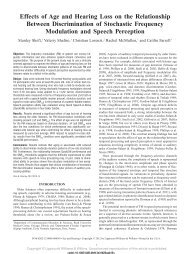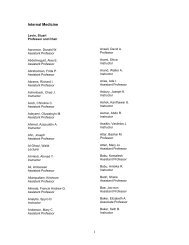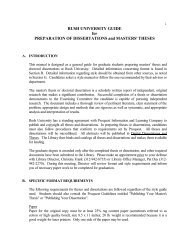Perceptual confusions of American English vowels ... - Rush University
Perceptual confusions of American English vowels ... - Rush University
Perceptual confusions of American English vowels ... - Rush University
Create successful ePaper yourself
Turn your PDF publications into a flip-book with our unique Google optimized e-Paper software.
It has been shown that pairs <strong>of</strong> segments that are allophonic in a language<br />
are perceived as being more similar than pairs that are contrastive in<br />
a language Boomershine et al., 2008. There is also evidence that neutralized<br />
contrasts in a language are perceived as more similar than nonneutralized<br />
contrasts Hume and Johnson 2003. Third, there is evidence<br />
that phonological relationships should be defined along a continuum <strong>of</strong> predictability,<br />
rather than as a categorical distinction between “allophonic” and<br />
“contrastive” Hall 2008. In combination, these facts predict that pairs <strong>of</strong><br />
segments that fall along a cline <strong>of</strong> predictability <strong>of</strong> distribution should also<br />
fall along a cline <strong>of</strong> perceived similarity. This paper presents results <strong>of</strong> a<br />
perception experiment that tests this prediction by examining the perceived<br />
similarity <strong>of</strong> four pairs <strong>of</strong> sounds in German: 1 t-tb, which is almost<br />
fully contrastive unpredictably distributed; 2 t-d and 3 s-b, which<br />
are each partially contrastive partially predictably distributed; and 4<br />
x-ç, which is almost fully allophonic completely predictably<br />
distributed. If the notion <strong>of</strong> a cline <strong>of</strong> predictability is correct, these four<br />
pairs will align themselves along a cline <strong>of</strong> similarity with t-tb being rated<br />
as the most distinct and x-ç as the most similar.<br />
FRIDAY MORNING, 22 MAY 2009<br />
SKY BRIDGE AUDITORIUM, 8:45 TO 10:10 A.M.<br />
Session 5aSWa<br />
Speech Workshop: New Perspectives on Models <strong>of</strong> Cross-Language Speech Perception<br />
Ann R. Bradlow, Chair<br />
Dept. <strong>of</strong> Linguistics, Northwestern Univ., Evanston, IL 60208<br />
Chair’s Introduction—8:45<br />
Invited Papers<br />
9:00<br />
5aSWa1. Accounting for the accented perception <strong>of</strong> <strong>vowels</strong>: Universal preferences and language-specific biases. Ocke-Schwen<br />
Bohn <strong>English</strong> Dept., Arhus Univ., J.-C.-Skous Vej 5, DK-8000 Arhus C, Denmark and Linda Polka School <strong>of</strong> Commun. Sci. and<br />
Disord., Montreal, PQ, H3G1A8, Canada<br />
Strange things happen in cross-language and second-language vowel perception: Nave non-native listeners have been reported to<br />
rely on acoustic properties which are nonfunctional in their L1 and dysfunctional for the perception <strong>of</strong> non-native <strong>vowels</strong>; naïve nonnative<br />
listeners’ perception is guided by a preference for <strong>vowels</strong> that are peripheral in the articulatory/acoustic vowel space; and, in<br />
general, naïve non-native listeners’ perception is not well predicted by comparative analyses <strong>of</strong> <strong>vowels</strong> <strong>of</strong> the native and the non-native<br />
language. This presentation reviews the accented perception <strong>of</strong> <strong>vowels</strong> by focusing on two forces which shape non-native vowel<br />
perception: universal perceptual preferences which non-native listeners and infants bring to the task <strong>of</strong> vowel perception, and perceptual<br />
biases which non-native listeners transfer from their native to the non-native language. Strange and her colleagues have shown that<br />
these biases cannot be predicted from acoustic comparisons; rather, they have to be examined directly through assessments <strong>of</strong> the perceived<br />
cross-language similarity <strong>of</strong> <strong>vowels</strong>. This presentation addresses several <strong>of</strong> the still unresolved questions regarding the design and<br />
the interpretation <strong>of</strong> perceptual assimilation tasks used to account for the accented perception <strong>of</strong> <strong>vowels</strong>. Work supported by Danish<br />
Research Council for the Humanities, Canadian Natural Sciences and Engineering Research Council.<br />
9:35<br />
5aSWa2. Articulating the <strong>Perceptual</strong> Assimilation Model (PAM): <strong>Perceptual</strong> assimilation in relation to articulatory organs and<br />
their constriction gestures. Catherine T. Best MARCS Auditory Labs, Univ. Western Sydney, Locked Bag 1797, Penrith NSW 1797,<br />
Australia, and Haskins Labs, 300 George St., New Haven, CT 06511, c.best@uws.edu.au, Louis Goldstein Univ. Southern Calif., Los<br />
Angeles, CA 90089-1693, Michael D. Tyler Univ. Western Sydney, Penrith NSW 1797, Australia, and Hosung Nam Haskins Labs,<br />
New Haven, CT 06511<br />
A core premise <strong>of</strong> the <strong>Perceptual</strong> Assimilation Model <strong>of</strong> non-native speech perception PAMBest 1995; Best & Tyler 2007 is<br />
that adults perceive unfamiliar non-native phones in terms <strong>of</strong> articulatory similarities/dissimilarities to native phonemes and contrasts.<br />
The implied attunement to native speech emerges early: As infants begin to discern the articulatory organization <strong>of</strong> native speech,<br />
language-specific effects in non-native speech perception appear 6–10 months. Given that non-native phones, by definition, deviate<br />
phonetically from native ones, how can we characterize articulatory similarity in concrete, testable ways The Articulatory Organ Hypothesis<br />
AO Studdert-Kennedy & Goldstein 2003; Goldstein & Fowler 2003 <strong>of</strong>fers a possible approach, positing that infants<br />
decompose the oral-facial system into distinct articulatory organs e.g., lips, tongue tip, tongue dorsum and are sensitive to their actions<br />
in producing vocal tract constrictions. Thus, between-organ contrasts should be easily perceived/learned by infants and adults, whereas<br />
detection <strong>of</strong> within-organ contrasts must become attuned to the distribution <strong>of</strong> differing constriction locations/types by that organ in<br />
input speech. We discuss articulatory, attunement modeling, and perceptual evidence consistent with these predictions, and present a<br />
revised version <strong>of</strong> PAM that incorporates the AO Hypothesis and related principles <strong>of</strong> articulatory phonology Browman & Goldstein<br />
1991. Work supported by NIH.<br />
2758 J. Acoust. Soc. Am., Vol. 125, No. 4, Pt. 2, April 2009 157th Meeting: Acoustical Society <strong>of</strong> America 2758


